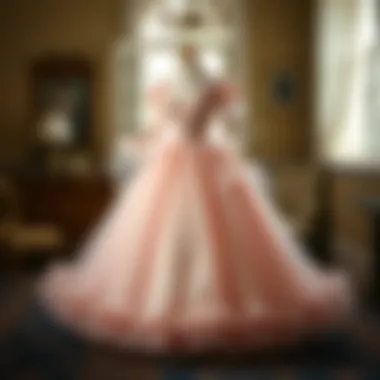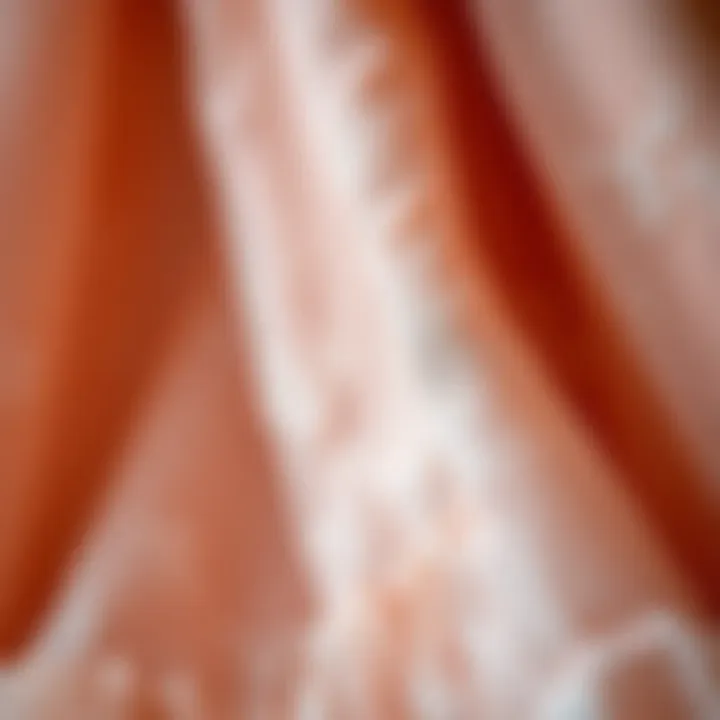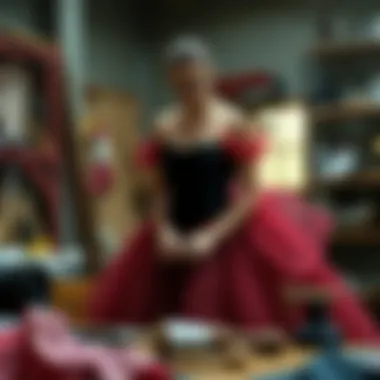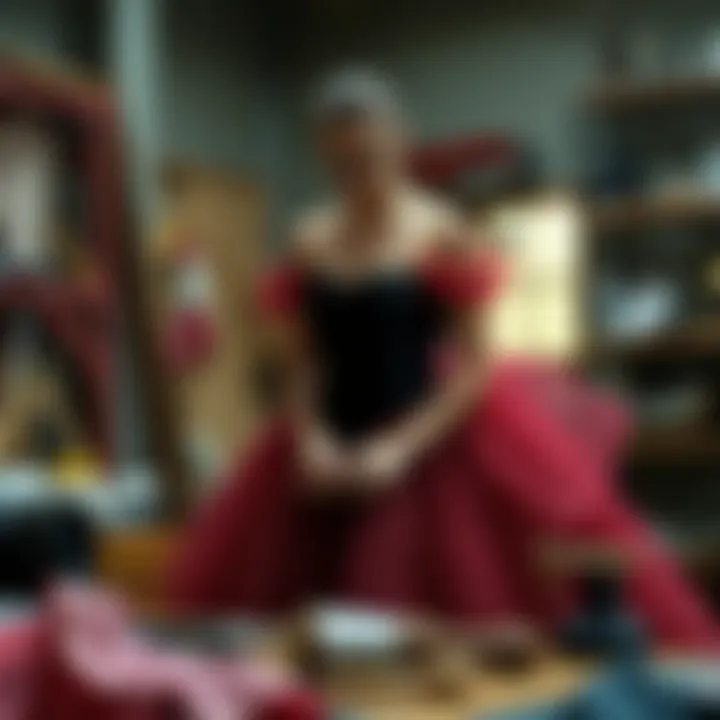Exploring Floor Length Crinoline: Trends and Techniques


Intro
Floor length crinolines have waltzed through our wardrobes, capturing imaginations and spotlighting the elegance of formal attire. Rooted deeply in history, they were once pivotal in enhancing the structural silhouette of women's gowns during the Victorian era. Today, they are no less than a canvas, reflecting personal style and the ongoing evolution of fashion.
In this article, we will explore the intricate world of floor-length crinolines, providing a comprehensive overview that runs the gamut from historical significance to modern styling techniques. Whether you're a stylist, designer, student, or simply a fashion enthusiast, the insights gathered here aim to enlighten and inspire. Expect to find rich discussions on the latest trends, practical style tips, and guidance on how to seamlessly integrate this unique garment into contemporary wardrobes.
Prelude to Floor Length Crinoline
Floor length crinoline plays a pivotal role in today's discussions about fashion, bridging the gap between historical significance and contemporary style. Understanding crinoline isn’t just about admiring its aesthetic appeal; it involves unpacking the versatility and architectural prowess that this timeless garment provides.
At its core, crinoline embodies elegance, serving as a canvas for designers to express creative freedom while adhering to the structural requirements of floor-length garments. The fabric's character adds drama and movement to any outfit, making it a staple for formal events, theatrical performances, and even avant-garde fashion shows.
One of the key benefits of incorporating floor length crinoline into one’s wardrobe is the ability to transform ordinary attire into something spectacular. With the right styling, a simple evening gown can evolve into a statement piece that catches the eye and garners admiration. Furthermore, crinoline has a unique ability to flatter various body types due to its structure, allowing wearers to showcase their silhouettes in an innovative way.
Considerations for Practitioners
For stylists, designers, and fashion marketers, recognizing the nuances of crinoline construction becomes essential.
- Fabric Selection: Different fabrics yield different drapes and finishes. Options can range from stiff, traditional materials to softer varieties, which allow for lighter, more playful looks.
- Styling Variations: It’s crucial to understand how crinoline can be paired with other garments. For instance, layering crinoline with a sleek bodysuit can create a striking contrast between textures and shapes.
- Cultural Context: Crinoline's global appeal transcends cultural boundaries, making it a subject of interest across fashion trends and styles. From ball gowns to modern chic ensembles, its versatility speaks volumes about its adaptability.
Aid your journey into crinoline with purposeful research and timely exploration. The more one comprehends the fabric's texture, its historical roots, and current trends, the better equipped they become to appreciate and innovate within this remarkable fashion domain. As we delve further into this article, we will celebrate crinoline's past, dissect its present, and speculate on its future to inform and inspire enthusiasts of all backgrounds.
Historical Context of Crinoline
Understanding the historical context of crinoline is not just about looking at old fabrics; it’s a dive into the very essence of fashion evolution. Crinoline has traveled through time, embodying social movements, cultural shifts, and significant changes in women's fashion. By exploring its past, one can appreciate how crinoline reflects broader societal values and aesthetics.
Origins of Crinoline
Crinoline, when stripped to its core, finds its roots in the combination of horsehair and linen, tracing back to the mid-19th century. But it’s not just a matter of textiles; it symbolizes a rebellion against the confines of previous fashion norms. The term 'crinoline' itself is derived from the French word “crin,” meaning horsehair, and “lin,” meaning linen. Initially, this fabric was rigid and uncomfortable, but it provided the much-needed volume that defined women's fashion of that era. This didn't just happen by chance.
Consider the 1840s, when women sought to project wealth and status through their attire. At that time, crinolines were not merely garments; they were a means of expressing individuality. Wealthy women showcased elaborate gowns that could be likened to small tents, holding a physical space just as they did social clout. Such layers of meaning enrich the fabric’s historical narrative.
Crinoline in the 19th Century
The story continues well into the 19th century, where crinoline became a household name, literally. By the 1850s, the crinoline skirt had transformed into a staple for upper-class women across Europe and America. It was not uncommon for these skirts to expand as wide as six feet, figuratively making a statement about the wearer’s social position.
Yet, this period also comes with its quirks. While crinoline provided an opulent silhouette, it also brought about practical concerns. For instance, the skirts were notorious for being cumbersome, and, on more than one occasion, they were implicated in tragic incidents like fires due to their volume and flammability.
The Industrial Revolution played a pivotal role in making crinoline accessible. With mass production, this once luxurious fabric became widely available, allowing many women to don it, regardless of their socioeconomic status. Thus, crinoline migrated from the elite drawing rooms to the bustling streets of burgeoning cities, transforming how women viewed their fashion choices.
Crinoline's Cultural Significance
By the end of the 19th century, crinoline was not just fabric; it had cemented itself into the cultural psyche of the time. The silhouette that crinoline created wasn’t only about style; it served to separate the feminine from the masculine, imbuing dresses with an air of authority and prominence.
Crinoline carried an atypical weight, reverberating messages of freedom and constraint. As women pushed back against restrictive dress codes, crinoline became a symbol of both liberation and constraint, sparking discussions about women's roles in society.
Interestingly, when crinoline began to fall out of fashion, it paved the way for the more practical and less voluminous styles, including tailored skirts and dresses which emphasized a new notion of femininity—one that resonated with the emerging women's rights movements of the late 19th and early 20th centuries.
"Crinoline wasn’t merely a piece of clothing; it was an emblem of societal change, encapsulating aspirations and barriers within its voluminous folds."
In summary, the history of crinoline encapsulates more than just textile trends; it reflects the nuanced relationship between fashion, societal changes, and cultural identities. Understanding its journey paves the way for insights into modern fashion and its enduring fabric heritage.
Understanding Crinoline Fabric and Construction
When delving into the world of floor-length crinoline, understanding the fabric and construction is key. Crinoline, with its rich history and evolving designs, is not merely a material; it is a statement of art and craftsmanship. The quality of fabric and the precision in construction directly influence the garment's drape, shape, and overall aesthetic appeal. Hence, the importance of this section lies in its ability to provide insights that could guide stylists, designers, and students in creating or selecting high-quality crinolines.


Types of Crinoline Fabrics
Crinoline has come a long way from its early days to a variety of modern iterations. Not all crinoline fabrics are created equal, and each type offers distinctive traits:
- Cotton Crinoline: Often used for traditional skirts, cotton crinoline is breathable and easy to work with. It provides a light structure and has a natural finish which many sewers appreciate.
- Polyester Crinoline: This fabric is a popular choice for those requiring durability and affordability. It can hold its shape well, making it perfect for formal wear, though it may not breathe as easily as cotton.
- Silk Crinoline: The crème de la crème of crinoline fabrics, silk offers a luxurious sheen and soft texture. Its delicate nature requires careful handling but yields stunning results for formal occasions.
- Stiffened Crinoline: Often used in creating dramatic silhouettes, this fabric is treated to have added rigidity. It works wonders in ball gowns and theatrical outfits, offering a strong architectural form.
- Horsehair Crinoline: A mesh-like fabric, horsehair is extremely lightweight and adds volume without bulk. It is usually used for layered skirts or as an inner lining, enhancing the garment's structure.
The Craftsmanship Behind Construction
Craftsmanship in crinoline construction cannot be overlooked. It is half the equation of creating a piece that not only looks good but also fits well. Each seam, stitch, and dart has a role to play:
- Pattern Drafting: A well-drafted pattern is the foundation of any garment, particularly when working with structured fabrics like crinoline. It dictates how the garment will hang and shape the final look.
- Sewing Techniques: Techniques like French seams and bias bindings can elevate the finish of crinoline garments, ensuring that edges are clean and the integrity of the fabric is maintained. Moreover, the right machine settings are crucial, as crinoline can easily fray.
- Layering Strategy: Understanding how to layer crinoline with other fabrics also matters greatly. A heavier fabric should be used thoughtfully to complement crinoline without overpowering it, while lighter fabrics can offer an airy feel.
The craftsmanship behind crinoline isn’t just about sewing; it’s about understanding how materials work together, how they move, and how they can best create the desired silhouette.
Innovations in Crinoline Fabrication
The world of fashion is never stagnant, and crinoline fabrication is no exception. Recent innovations are shaping how this age-old fabric is perceived and utilized:
- 3D Printing Technology: Emerging technology has introduced the ability to 3D print lightweight crinoline structures that can add fascinating textures and patterns, allowing designers to push the boundaries of traditional garment making.
- Smart Fabrics: Innovations in textile science have led to the creation of crinoline fabrics that can regulate temperature or change colors with heat or light exposure. These fabrics cater to a new age of interactive fashion.
- Sustainable Alternatives: Eco-conscious designers are experimenting with materials made from recycled plastics or organic fibers. This shift not only appeals to environmentally aware consumers but ensures that the allure of crinoline can persist in a sustainable manner.
- Hybrid Fabrics: The blending of synthetic and natural fibers is creating crinolines that offer both structure and comfort, allowing a broader range of motion while still maintaining the dramatic flair that crinoline is known for.
In essence, understanding crinoline fabric and construction is about grasping the nuances of texture, structure, and innovation. It empowers fashion professionals to make informed choices, ensuring that their creations not only pay homage to tradition but also embrace modernity.
"The fabric of a garment is not just its skin but its heart and soul. It tells a story before a word is spoken." - Unknown
For further understanding, you might want to check out articles on Wikipedia for historical insights, or explore case studies from contemporary designers on Britannica.
Styling Floor Length Crinoline
Styling floor length crinoline is a pivotal aspect of incorporating this exquisite fabric into a modern wardrobe. Its voluminous structure offers a canvas for creativity, allowing stylists and fashion enthusiasts to tailor outfits to different occasions and personal tastes. As fashion trends continuously evolve, knowing how to style crinoline can help highlight its unique characteristics, transforming an ordinary look into something striking and memorable.
Whether it’s for a formal event or a whimsical daytime outing, understanding the nuances of styling floor length crinoline adds a layer of sophistication that speaks volumes about a wearer’s fashion sense. The versatility of this garment provides opportunities to experiment with various silhouettes, textures, and colors, ultimately enhancing a person’s overall aesthetic.
Pairing with Various Outfits
When it comes to crinoline, pairing is key. This sumptuous fabric can accentuate an array of garments, from dresses to skirts, and even overlaid tunics. Consider the following suggestions for successful pairing:
- Dress Choices: A fitted bodice often works hand in hand with a voluminous crinoline skirt. For instance, a sleek satin or lace top paired with a flowing crinoline bottom creates a balanced silhouette.
- Layering: For an artful approach, layer a crinoline under a plain maxi skirt or dress. This not only adds volume but also introduces depth and texture to the ensemble, creating a fashion-forward look.
- Contrast: Don’t shy away from mixing textures. Pairing crinoline with denim or leather can create an unexpected yet striking contrast. A crinoline peeking underneath a structured leather jacket can evoke a playful edge.
By taking these considerations into account, stylists can craft outfits that celebrate the beauty of floor length crinoline, ensuring each ensemble has its own personality and flair.
Seasonal Styling Tips
Adapting crinoline for different seasons can be a clever way to bring this timeless fabric into regular rotation. Here are several tips to keep in mind:
- Spring and Summer: Light, airy fabrics work wonderfully with crinoline. Opt for floral patterns or pastel colors for a breezy feel. Pairing crinoline with a simple tank top or a fitted T-shirt can create a relaxed yet stylish look.
- Fall and Winter: Consider heavier fabrics and layers. A cozy knit sweater layered over a crinoline skirt can keep one warm while still looking chic. Darker hues, like maroon or deep green, often fit the mood of the season.
- Transitional Outfits: Embrace a mix of seasonal elements. Pair a cropped leather jacket over a summer sundress with crinoline underneath to seamlessly blend seasonal styles.
The right approach to seasonal styling ensures that floor length crinoline remains a staple no matter the time of year.
Accessorizing Crinoline
Accessories can make or break an outfit featuring crinoline. The trick is to find the right balance. Here are some effective accessory tips:
- Footwear: Choosing the proper shoes is crucial. Heels work well to elongate the silhouette, while ankle boots can add a grounded, edgy feel.
- Jewelry: Opt for statement pieces that resonate with the overall vibe of the outfit. For a more whimsical feel, colorful earrings or playful bracelets add a touch of fun. Conversely, refined, elegant pieces like pearls can elevate the look for formal events.
- Belts: Using a belt can define the waist, especially when styled with a high-waisted crinoline skirt. It not only enhances shape but also introduces a new layer of texture.
Key Point: Accessorizing crinoline is about achieving harmony. Too many accessories can overwhelm the fabric's natural elegance, so strive for balance and focus on a few impactful pieces.
In summary, styling floor length crinoline opens a myriad of possibilities. From pairing with various outfits and applying seasonal insights to wisely accessorizing, there’s no limit to the creativity one can exercise. With this understanding, stylists and fashion enthusiasts can harness crinoline’s timeless elegance, making it their own in today’s fashion landscape.


Crinoline in Modern Fashion
The evolution of crinoline in modern fashion marks a fascinating convergence of tradition and innovation. With its deep-rooted history and dramatic flair, crinoline has proven to be not just a fleeting trend but a persistent silhouette making a comeback on contemporary runways. This section takes a closer look at the modern manifestations of crinoline, particularly how contemporary designers integrate this fabric into their creations, the vibrant fashion shows that showcase it, and the undeniable influence of celebrities on shaping crinoline trends.
Contemporary Designers Embracing Crinoline
Designers today are rekindling an ancient love affair with crinoline, breathing fresh life into its classic forms. Notable names such as Alexander McQueen and Dior have revisited crinoline, reinterpreting its voluminous structure in collections aimed at modern audiences. These designers ingeniously weave crinoline into their garments, using it to craft towering skirts that flaunt feminine elegance while pushing the boundaries of architectural fashion.
For instance, the 2021 collection by Erdem featured dresses that fused crinoline with ethereal layers. This blending creates a striking contrast that appeals to both traditionalists and fashion-forward enthusiasts. Furthermore, Zuhair Murad often employs crinoline in his gowns, using its stiffness to construct bold shapes that command attention on every red carpet.
"The use of crinoline allows designers to express creativity on an entirely different scale, offering a canvas that does not just drape but constructs."
Fashion Shows Featuring Crinoline
Fashion shows have become ground zero for debuting crinoline-inspired pieces, where the excitement of the runway can be almost palpable. Major events like New York Fashion Week and Paris Haute Couture are instrumental in showcasing crinoline's dramatic presence.
In recent years, the Chanel Spring/Summer showcase had models gliding down the runway in crinolines that seemed to defy gravity. Such a spectacle underscores the fabric's tradition while allowing it to stand uniquely within a modern context. Additionally, the Valentino runway presented a series of floor-length crinoline skirts styled with plush knitwear, merging comfort with haute couture.
These high-profile events draw attention not just from industry insiders but also from a broader audience, leading to an uptick in mainstream interest towards crinoline. The visibility gained in these venues is invaluable, propelling the fabric back into public consciousness as a stylish option.
Celebrity Influence on Crinoline Trends
Celebrities have a way of making trends that can be both instantaneous and enduring. When stars like Emma Watson and Laverne Cox step out in crinoline-based garments, they catalyze a wave of interest among fashion enthusiasts. Their stylistic choices often lead to a barrage of social media posts, which further amplifies the visibility of crinoline.
Take for instance the buzz surrounding Lady Gaga's iconic crinoline skirt at an award show. Such bold appearances not only serve as a statement but also inspire fans and upcoming designers to explore this timeless fabric.
This celebrity endorsement plays a critical role in shifting perceptions of crinoline, showcasing it as versatile—not just for formal events but as a suitable choice for various occasions. This resonance further solidifies crinoline's comeback narrative, giving it a place in the everyday wardrobe of those eager to make a statement.
In summary, crinoline in modern fashion is a tale of renaissance. With contemporary designers adopting its structure, fashion shows establishing its relevance, and celebrities championing its allure, crinoline is positioned as a must-have for both aesthetic charm and craftsmanship. It invites a deeper exploration of fashion that balances historical appreciation with modern innovation.
Practical Considerations
When diving into the world of floor length crinoline, practical considerations become paramount. This topic sheds light on essential elements that every fashion professional should keep in mind. Understanding these facets not only enhances the overall experience but also ensures that the garments worn are both visually stunning and functional.
Care and Maintenance of Crinoline
Caring for crinoline may seem like a chore, but it’s crucial to maintain its shape and longevity. Crinoline can be a delicate fabric; improper handling could lead to unintentional wear and tear.
- Washing: It is advisable to hand wash crinoline in cold water using a gentle detergent. If machine washing is preferred, place the garments in a mesh laundry bag to minimize friction and snagging. Always check the care tag before proceeding with any method.
- Drying: After washing, avoid wringing or twisting the fabric. Lay it flat to dry, if possible. Hang drying can be beneficial but keep it away from direct sunlight to prevent fading.
- Storage: When storing crinoline, fold it gently and use acid-free tissue paper to maintain its structure. Avoid cramming it into tight spaces—allowing it to breathe is essential. Regularly check for pests that might cause damage.
The objective is to keep the fabric in prime condition, ready for any occasion it’s meant to grace.
Fit and Comfort
Another pivotal aspect is focusing on fit and comfort. A beautifully crafted crinoline can be rendered useless if it isn’t comfortable to wear. Fit can vary significantly from designer to designer and even from one garment to another. Here are a few keys to remember:
- Size Up or Down: Don't be shy about trying multiple sizes. It's better to step up a size and find a knowledgeable tailor than to squeeze into an ill-fitting piece.
- Layering: Consider how layers will interact. Crinoline often requires adjustments based on what lies beneath. Make sure other clothing pieces don't restrict movement or comfort. If it’s going over a fitted dress, make sure the crinoline doesn’t create unwanted bulges.
- Comfort Test: Walk around in the garment before making a decision. What looks fantastic on a hanger might feel like a straightjacket when worn.
Budgeting for Crinoline Pieces
Budgeting plays a significant role in acquiring crinoline garments, as prices can range widely based on fabric, brand, and craftsmanship. Here are a few considerations to keep in mind:
- Quality vs. Cost: There's a common phrase: "You get what you pay for." Lower-priced crinoline can often compromise on quality. It could be worth investing a little more for a piece that holds its shape and integrity.
- Plan for Alterations: Don’t forget to budget for tailoring. Sometimes a piece's original price tag can be misleading when you factor in adaptation costs.
- Sales and Discounts: Keep an eye on seasonal sales. Many high-end designers offer discounts during off-peak seasons. Also, consider second-hand options; vintage shops often carry unique pieces that might be a fraction of the original price.
- DIY Options: If you're handy with a sewing kit, consider potentially customizing your own crinoline. It might save costs and provide a personalized touch that makes the garment truly yours.
By considering these practical aspects with care, fit, and finances, one can make informed decisions about incorporating floor length crinoline into their wardrobe, enhancing both style and sustainability.


Crinoline's Ecological Impact
Understanding the ecological impact of crinoline is essential as we move towards a more sustainable fashion industry. This unique fabric, steeped in history, demands careful consideration when it comes to its production and lifecycle. With growing environmental concerns, it's clear that crinoline's journey from creation to disposal plays a significant role in the overall ecological footprint of the fashion sector. By addressing sustainable practices in its production and distribution, we not only honor the artistry of crinoline but also contribute to global sustainability efforts.
Sustainable Materials in Crinoline Production
Using sustainable materials in crinoline production can drastically reduce its environmental impact. Natural fibers like cotton, linen, and hemp have been gaining traction as viable alternatives to synthetic options such as polyester. These natural materials are often biodegradable and renewable, making their integration into crinoline much more desirable.
- Organic Cotton: This is cultivated without harmful pesticides or synthetic fertilizers, enhancing soil health. It's softer and dyes better, allowing for vibrant colors without the environmental cost.
- Linen: Made from the flax plant, linen is not only strong but also requires less water compared to cotton. It’s a perfect choice for crinoline that embraces both elegance and ecology.
- Hemp: Known for its durability, hemp grows quickly and needs minimal resources. Using hemp for crinoline fabric reduces the pressure on our water supplies and promotes healthier soil.
Additionally, producers are exploring innovative, eco-friendly methods for dyeing and finishing these fabrics to abide by stringent environmental standards. By moving towards a closed-loop system, where waste is minimized and materials can be reused, the industry can lessen its detrimental impact.
Eco-Friendly Practices in the Fashion Industry
The fashion industry, crinoline included, has started embracing several eco-friendly practices that aim to lower carbon footprints and promote sustainability. It’s no longer just about looking flashy; there’s a strong push towards being responsible too. Here are a few notable practices:
- Zero-Waste Design: Designing garments in a way that minimizes fabric waste during the cutting process has become more common. Crinoline pieces can be fashioned so that nearly all the material gets utilized.
- Local Production: By sourcing materials and crafting garments closer to where they are sold, designers can cut down on transportation emissions. Supporting local artisans helps to maintain traditional craftsmanship while reducing the carbon output.
- Repair and Upcycling: Encouraging consumers to repair rather than discard their crinoline allows these garments to live longer. Offering workshops on how to care for and alter crinoline garments can foster a culture of sustainability.
"By choosing eco-friendly practices, fashion designers can not only cater to the modern consumer's demands but also play a pivotal role in environmental conservation."
Encouraging awareness about the ecological impact of crinoline assists both designers and consumers in making informed choices that favor sustainability. As crinoline makes a resurgence in modern fashion, acknowledging and addressing its environmental implications becomes a shared responsibility among all stakeholders in the industry.
The Future of Crinoline in Fashion
The landscape of fashion is ever-changing, yet some garments hold a timeless allure, and crinoline is no exception. The future of crinoline in fashion appears bright as contemporary designers and consumers pursue new interpretations of this historical piece. This section delves into the evolution of crinoline, focusing on emerging trends and its role in fostering a more inclusive fashion scene.
Emerging Trends and Innovations
As we glance toward the future, several key trends are shaping how crinoline is being reimagined. One notable trend is the amalgamation of traditional techniques with modern materials. Designers are increasingly experimenting with lightweight, breathable fabrics, such as organza and tulle, which offer the same structural integrity as traditional crinoline but with added comfort. This innovative approach allows for more dynamic silhouettes, making it easier to incorporate crinoline into everyday attire.
Another significant movement is the rise of customizable crinoline pieces. In a world where personalization reigns supreme, fashion enthusiasts now seek garments that can reflect their unique identities. Brands are embracing this by offering options that allow buyers to choose colors, lengths, and even embellishments, making crinoline accessible to diverse body types and personal styles.
Furthermore, crinoline is also experiencing a renaissance in the realm of sustainable fashion. More designers are integrating eco-friendly materials, such as organic cotton and recycled fibers, into their crinoline constructions.
"Fashion's future lies in sustainability, and crinoline can play a significant role in this narrative."
Embracing such materials not only enhances the ethical aspect of fashion but also attracts environmentally conscious consumers looking for grace and responsibility in their wardrobe choices.
Crinoline in Gender Fluid Fashion
The fashion industry is fast becoming a hub of inclusivity, breaking down long-standing gender norms. Crinoline, with its voluminous structure, is particularly well-suited for gender fluid fashion. This garment transcends the rigid constraints of tailored suits and form-fitting shapes typically associated with traditional masculinity or femininity.
In recent collections, designers are crafting crinolines that can be worn by anyone, regardless of their gender identity. This includes adaptations in styling—pairing crinoline skirts with oversized blazers for a more androgynous look or layering with athleisure to blend comfort with elegance. These combinations challenge preconceived notions and invite experimentation.
Moreover, fashion influencers and public figures have taken to social media to showcase how crinoline can be worn in various contexts, thereby expanding its appeal across diverse audiences. Their visibility can do wonders in normalizing crinoline as an everyday choice, no longer relegated to formal occasions or women's wear. Through these efforts, crinoline evolves from a historical relic into a modern statement of individuality.
The future of crinoline is set on a progressive course as it navigates the realms of innovation and inclusion. With trends pointing toward sustainability, affordability, and adaptability, crinoline is bound to remain a relevant and celebrated element in the ever-diverse world of fashion.
Epilogue
In wrapping up our exploration of floor length crinoline, it's vital to reflect on the multifaceted elements that contribute to its significance in fashion. This article provided a comprehensive guide, illustrating not only the historical context but also the intricate techniques involved in its creation and styling.
Understanding crinoline is akin to uncovering a rich tapestry of culture, craftsmanship, and creativity. From its origins and evolution within the 19th century to its resurgence in contemporary fashion, the importance of crinoline resonates through various layers. Whether you are a stylist curating a collection, a designer crafting innovative pieces, or simply a fashion enthusiast, crinoline serves as a unique canvas that allows for endless creative expression. Its versatility in pairing with different outfits and accessory styles confirms its place in both traditional and modern wardrobes.
Moreover, the insights into sustainable practices reveal a crucial consideration for today’s fashion landscape. As consumers become increasingly aware of ecological impacts, the shift towards sustainable materials in crinoline production sparks a necessary dialogue within the industry. This reflects broader trends of responsibility within fashion, bridging the gap between elegance and environmentally-friendly choices.
In essence, crinoline is more than just a garment; it is a symbol of evolution in fashion, blending heritage with modern considerations. The techniques and styles discussed encourage a deeper appreciation for not just what crinoline represents, but also how it can be seamlessly integrated into contemporary fashion narratives.
It’s clear that, moving forward, crinoline will continue to inspire and challenge designers, igniting future trends while remaining a staple in formal attire. As we look ahead, the role of crinoline will be one of balance—preserving its historical roots while innovating for the future.
"Fashion is the armor to survive the reality of everyday life." — Bill Cunningham. This quote underlines the purpose of crinoline, as it aims to elevate one's presence and confidence in any setting.
For more detailed information on crinoline and sustainable fashion practices, you can check resources like Wikipedia and Britannica.















